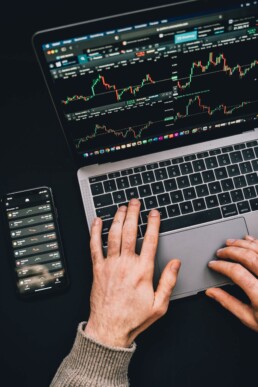Trading vs Investing, with Bitcoin
In this article we talk about bitcoin trading, specifically seeing the difference between investing and trading.
First of all we need to define what bitcoin trading is.
Bitcoin trading is the exchange of fiat currency or other cryptocurrencies for bitcoin, on an exchange, with a short-term vision and then returning to fiat currency by exploiting the high volatility to gain in fiat currency.
We must understand that the difference between investing and trading refers specifically to the long or short term view. In fact, investing means buying bitcoin today and then reselling it in 3 4 or more years, regardless of its movements. Trading bitcoin, on the other hand, means taking advantage of its movements to make money.
The two views are both correct and are the result of two different points of view. Investors generally believe in the underlying technology and ideology of Bitcoin, seeing in it a possible bright future for the asset. Traders, on the other hand, may not be interested in technology but are interested in the short-term economic potential of the instrument, so ups and downs are welcome when positioning in a trend.
The two visions can be experienced simultaneously. Nobody forbids you to put some bitcoins away on a wallet for the long term and at the same time trade others for the short time.
A popular slang term in the bitcoin world is hodl, which refers to someone who has long-term invested in bitcoin. The term comes from a mistake that has become popular on the bitcoin talk forum.
At every big down fall, don't panic and hodl!
Traders not interested in bitcoin technology consider it an interesting asset for their work as the market is open 24 hours a day all year round. The volatility of the currency and its riskiness are the perfect fuel for day traders and swing traders.
One last observation. Don't turn a short-term trade into a long-term investment just because the market has gone in the opposite direction to what you thought and your loss percentage became important because you didn't use the stop loss.
Tax Havens
Today we lie down in the sun in full relaxation and talk about tax havens.
A tax haven is basically a low or no taxation country for resident businesses or individuals. They are considered refugees from states that have exaggerated taxation.
Generally the banking system allows transactions to be carried out that are covered by banking secrecy and the administrative management for the creation of companies is very quick and lean.
It must be understood that if tax havens exist, tax hells must exist somewhere.
Are tax havens legal? Yes.
Are tax havens fair? It depends on what our point of view is, which is obviously linked exclusively to companies operating in sectors that has no link to criminality.
If we look at the large sums being taken away from high-tax states, it is clear that tax havens are unfair. Countries like Panama don't have the needs and expenses of normal European countries. Companies operating in high-tax countries benefit from the state services of these countries and therefore should remunerate them.
From the other point of view, however, it is easy to understand that a country with low or no taxation gives to any company a competitive advantage given the saving of money from taxation, money that can be reused in research and development, higher salaries, bonuses and all that. which is needed for company and employees.
Another interesting point to understand is that there is now a competition between nation states in the world of globalization. There have been those who are administratively friendlier to companies, which offer greater advantages and which encourage companies to put their offices there. Places like Luxembourg, the Netherlands or Ireland have understood this dynamic and built a competitive advantage. Other countries, on the other hand, which have inefficient and expensive state welfare systems, are forced to over-tax their citizens.
In today's world, where competition is getting stronger and many barriers have been destroyed, it is easy to understand that every competitive advantage need to be used. States and governments that do not understand this are destined to lag behind on the international scene and with them their economies and the prosperity of their citizens. Being more inclined to favor companies by lowering taxes and bureaucracy, improving and decreasing the state machine, could be the ideal solution to make sure that tax havens no longer exist.
Renting or buying a house?
Renting or buying? Buying or renting?
And is renting really a complete waste of money?
In fact, the question that many are asking is "why pay the rent to the homeowner if I can pay for my home directly?"
To answer this question we must start from the beginning of the question and analyze the situation one piece at a time. And the only thing that makes sense is to analyze the problem over the long term.
First of all, renting a house is not throwing money into the fireplace, but it means having the use of an asset, in this case a house or an apartment. you are paying for the use of space that has no value to you in the future. This concept is basic, the value in the future is the key.
When you buy a house, and in almost all cases you are buying it making debt with a mortgage, you are borrowing money instead of a property and therefore you will pay the debt first, and then the interest for the use of this liquidity.
It should always be remembered that the money you borrowed today is used to buy an asset that will hopefully increase in value tomorrow.
It should also be considered that when the bank makes you a loan, you do not always have all the necessary money for the lend since not all banks provide 100% loans. So you will need to have a place to live for this period.
Another point to be sure of is what is expected in the short term. If you work in a company that sends you around the world, does it make sense to buy a house? If you change jobs and cities often, does it make sense to buy a house?
Being the owner of a house when you decide to take root and create a family is beautiful, but all the expenses that a property entails must be considered, therefore ownership taxes, purchase taxes, writing taxes, possible breakages of part of the house, checks to do at home, management fees and services without having to talk about house bills.
Those who are renting, on the other hand, have only the cost of the rent, insurance, various expenses and bills. And a much easier chance to move if the area gets worse or coexistence with neighbors becomes impossible.
Remember that needs and requirements change over the years, especially if the family grows with one or two children. Buying a house for two people and then having to live there in 4 is not easy but living there 35 or 40 years is certainly more economically viable than living in rent for the same time, especially because after 40 years you will be the owner of a property that will have a value.
But think about how many things can change or go wrong in 40 years, think about the divorce rate in your country.
The issue is difficult to tackle on a general level since each of us has different ideas, ways of life and expectations of the future. The real estate market is a market that must be studied and understood like any market and which is subject to price fluctuations. Many personal factors need to be considered before making the final decision.
Buying a house is simple, much more difficult is having to sell it. Always without falling into the debt trap
Diversification
Today we will understand how diversification works.
Diversification is an investment strategy to lower the risk factor on the markets and the global economy. You must always remember that the stocks or bonds you buy on the market are issued by companies that work, produce, take risks and make mistakes.
Only those who do nothing are never wrong o never make mistakes.
These risks and errors can be of various kinds, from the administrative level to company management or they can change situations or laws that outline the correct policies regarding companies in a given territory. Many of these issues are visible with a long-term view, but very often it happens that problems suddenly fall out of the sky.
So a common sense strategy might be not to put all your eggs in one basket, but to have your money invested in various companies, so that an attack on one company doesn't cause you to lose all your money.
This is to reduce the risk of the portfolio.
This kind of strategy works best only when your asset position arent correlated, that it means that a financial asset is affected to rise or fall in price, due to the rise or rise in the price of another financial asset. To take an example, think of the value of gold and the value of mining shares, or of oil and the shares of oil companies.
If you want to understand if your investments are uncorrelated, look for some tools on the internet that can help you.
A good general way to diversify is to invest in different industries in different sectors.
Given that each sector encounters different and unique risks. The same goes for when we think about different countries or continent. Different countries have different risks and problems
Globalization has helped us with the possibility of investing our money in different countries of the world, but this has meant that the correlation between the various companies even from different continents increased, just think of how Western companies are only linked to the supply of raw materials and semi-finished products from Asia.
Diversifying is not a quick and easy strategy, quite the opposite. We need to spend a lot of time studying the various issues and then studying the various companies that may interest us. Creating a risk-free portfolio is nearly impossible but doable.
We will then have to be careful about the costs of creating the portfolio given the amount of positions we could open.
ETFs are a good choice, but that's your job. Study and choose the best for you and your family's financial life. Remember not to run into a false diversification by buying different assets but which then have the same underlying.
Always remember that your goal is to safeguard the account, avoid large drops in its value and limit volatility by controlling risk.
Dividends
Today let's talk about what dividends are and why we like them so much.
Dividends are funds, money, that companies give to those who own their shares. Generally speaking, we do not talk about very large figures per share, but having so many shares the figure begins to be interesting.
In fact, owning this kind of shares leads to having extra cash flow in our account. A gain is not only made by buying and selling the shares but also by owning these dividend-paying shares.
Now, the first thought that comes to mind is that a stock portfolio can only be made up of dividend-paying stocks, but you have to be very careful. In fact, it is a good strategy but it has inherent problems.
Theoretically, companies pay dividends when they think they cannot increase their earnings by reinvesting in the company. Very often dividends are used as a tool in the hands of companies to remunerate part of the management and part of the corporate stakeholders.
This is why dividends are paid more easily by companies that have been on the market for some time and not by new companies that need to reinvest in themselves or that do not even have this liquidity.
The corporate sector also plays a role in paying dividends. some sectors are more inclined like the energy and oil sector, where only it is easier to create long-term contracts with sovereign states, with large and certain cash flows. These are stable operations in a "slow" market.
The companies of the new economy instead work in a very fast market, much more fluid and with big technological changes that does not lend itself.
Dividends can be a great solution for income investors, like those who invest to get money into their portfolio.
The risk management of dividend stocks is slightly different from others. In fact, one is led to think that companies that give dividends are more disciplined, giving a sense of security to the investor. In this way, the investor himself has a management that can be simplified having a certain annual return.
One of the possible strategies with dividends is to reinvest buying other stocks that will pay more dividends and so on for years to come.
It must be said that having a dividend-only portfolio is an interesting idea, but we must also understand that to have interesting figures we will have to immobilize an important figure on the stock market, which is notoriously risky and volatile. Stocks can crash and companies can make mistakes that can lead them to eliminate dividends. Unfortunately, the market does not appreciate this move and that company's stock could suffer a further collapse.
Dividend stocks are attractive but should not be abused.
Gold
Since ancient times, gold has been associated with wealth, money and well-being for those who owned even a small part of this asset. It was one of the most sought after materials extracted from the bowels of our planet, and the human being has always seen the value given by its scarcity.
Used since the dawn of time to give value to the currency of all peoples, we Westerners had the gold standard until the beginning of the 20th century, in fact the value of the currency issued by our central banks was linked to gold, which guaranteed its value.
This system was completely abandoned in 1971, but many still consider gold a fundamental asset for their investment portfolio.
In fact, gold is considered a refuge or a safe haven, where to take refuge every time the shadows of galloping inflation returns to disturb our sleep. Especially for critics of fiat currencies, gold is an excellent investment to maintain or increase the value of one's investments and to protect themselves from the wild printing of money created with Fiat currencies
Remember that gold is a finite resource on our planet, hardly available and in limited numbers.
Central banks in countries that didn't have much have been buying it up in recent years.
Many countries have large quantities declared while other countries have preferred to discard them. This is a good example of the different strategy of the various central banks.
Gold is also an industrial metal used in the production of electronic parts. In reality, its industrial demand is a small part of the world total, to which must be added the demand for raw materials for the production of jewelry.
Now we should ask ourselves, is it right to invest in Gold?
Well, as in all things, there is a better time to do things, and these can only be understood by studying the set-up in detail
Having a share of capital in gold is not stupid, quite the opposite. However, this must be seen primarily as a defense tool. This does not mean that you cannot make money with gold, but as always you have to follow the trend.
If we talk about price, by convention and general rule, the price of gold grows more and more than inflation and this is not related to the trend of the stock market.
In the event of a stock market crash, there is usually a rush to grab gold, and then sell the gold when the stock market rises vigorously
However, Gold has a volatile price and not a fixed price. The period and time of purchase must always be considered and what tools we are monitoring.
In fact, there are more methods and tools to be invested in gold.
The main differentiation is between physical gold and financial gold.
Financial gold is the gold that we can buy through financial instruments such as ETFs and ETCs, futures or derivatives. In this case we will not physically have gold in our hands but we will have financial contracts that represent the amount of gold we own that we will be able to trade on the main world markets. Obviously in this case the choice must be careful with regard to the instrument and all its peculiarities, relying on issuing companies that are more than reliable.
Physical gold, on the other hand, is the gold that we can take home and touch with our hands. Generally it is not just about jewelry, but also coins or bars, which can range from a few grams to a kilogram. The unit of measurement of gold is the ounce compared to the US dollar. This gold can be kept in your home, obviously safe from buglar or scammers. Given the high value of the metal, if you decide to buy more than a few ounces, it makes sense to contact specialized custodians to keep our investment safe.
In fact, there are real risks to owning it, not just financially, but personally. Gold is not an investment for everyone.
Another way to be part of this market is to expose yourself by buying shares in mining companies. This is another method which, however, is totally financial and which must be considered and studied like any financial investment, to which the risk of the sector in which these companies operate must be added.
Long or Short
This is a short article that will explain some of the terms that you can find in the world of trading.
Learn more about exchange here and here.
You will often hear from people in the environment talking about being Long or being Short
This is the result of a diametrically opposite view of the market by the trader.
Being Long means having purchased the financial instrument.
Being short means having borrowed the financial instrument.
In fact, in the world of trading we can not only buy an asset, assume a share or a cryptocoin, but also borrow it. It all depends on how we consider the future trend of this action, like the rise or fall of the price.
The market can be defined as bullish or bearish, in the event that it is increasing in value or losing value. There are two animals that describe the uptrend or the downtrend
The bull is the uptrend market. In fact, it is defined as the bull market. The bull strikes from the bottom up.
The bear is the downtrend market. Hence Bear Market, as the bear strikes from top to bottom.
Long means being the owner of the asset. Our hypothesis is that the market is bull so the asset's value will go up so we will wait for the value to rise to sell it at a higher price
Being short means that we think the value of an asset will go down, we will be in a bear market, so we are going to borrow the asset from a lender. We will sell our asset at € 5, it will drop to € 3 and we will buy it back at this amount so as to give it back to the previous lender. The 2 euro difference is your earnings
Always check your broker's costs regarding being short, they must be carefully monitored to manage them in the best possible way.
How negative interests works
Today we explore the topic of interest rates, and we will see what negative interest rates are and how they operate.
What is a negative interest rate?
A negative interest rate is a loan, granted by a financial entity, where you do not pay to take money but you are paid to access this loan.
A debtor who is paid to take a debt.
Fantastic.
BUT What do negative interests on the economy really mean?
Interest is the amount that you pay to the bank to borrow money for your business or family activities, or it is the money that is credited to you by the bank to hold your funds in your bank account.
The low rates are created to push banks to increase lending and not keep a lot of liquidity stored in their accounts, flirting with customers that need to access these low-cost loans.
High interest rates are used to push people to spend less and try to keep inflation under control by cooling the economy.
The opposite is created by lowering rates.
The ECB European Central Bank started with negative rates in 2014 while the central bank of japan started in 2016
With negative rates, banks will begin to lose profit from the money deposited in their customers' accounts.
Negative interest also means that deposit accounts and money held on checking accounts will be paid at zero or you will have to pay to keep yopur accounts in the bank. In this case the bank could decide to absorb this cost from their customer if they take other products of the bank such as insurance, mortgages, etc.
It happened in denmark that a bank applied a rate of -0.5%
Consumers are so discouraged from keeping cash in their checking accounts and are therefore pushed to spend. This affects the entire economic chain, both private and corporate.
The costs for loans to the public will certainly be higher than those that the bank will have, after all it is their business
In the case of negative interest decided by the central bank, consumers do not necessarily have to have negative interest on their loans as well.
At the moment, we do not fully understand the real consequences of negative interests on the real economy, despite the fact that these seem an excellent thing to the man in the street.
Theoretically, low or even negative rates serve to push the economy with greater consumer spending, a greater propensity to borrow and a growth in consumption and therefore a growth in inflation.
With inflation, or the growth of consumer prices, there is a loss in value of the currency of the country that is the victim,
which means a greater possibility of selling their products abroad given their lower value at the exchange rate with competitors, another boost to the demand for goods and services.
All good, if it happens.
The countries that are now protagonists of this financial policy based on negative rates have had problems with chronic slow growth and are therefore in deflation.
Deflation encourages banks and people not to spend their money.
Deflation leads to the cycle more saving less spending. negative interests are seen as a method to discourage this cycle and indeed reverse it
Negative interests can have many negative effects on the economy and the population. People may decide to own their savings in physical currency, creating a run at ATM instead of keeping their cash in bank accounts and then paying the banks fee.
Financial bubbles are another effect, people could borrow to an unsustainable level and then create a financial bubble, with all that goes with it. Do you remember our toxic assets?
Which means making risky investments with money that savers cannot afford to lose. In the event of a crash the situation would be really problematic.
Negative interest then affects savers and bond investors. Savings are no longer remunerated and bond yields go to 0,
the risk is no longer correctly remunerated, creating market distortions, which leads to an increase in the risk in the investment portfolio to maintain the same level of remuneration.
Think about how all pension funds and bond funds are affected
Companies take debt money not to create new production lines or increase their workforce, but to buy back their shares, artificially increasing their value on the market
Banks are also affected, as this action greatly lowers their profits on loans and other products.
Negative rates can be seen as paradoxical and controversial
Negative rates on various bonds lead to not placing the bonds on the market, since in a normal market no one lends their money without having an economic return.
On the contrary, we must mention the Safe haven bonds have a low if not non-existent yield, but we are talking about bonds issued by countries considered “safe” and “unshakable”.
Shadow Banking
Today we are going to learn what is the Shadow Banking,
While the name may sound like something secret or illegal, this is just a parallel system to the traditional banking system for lending to individuals and businesses. Nothing illegal
Let's take an example to simplify the general explanation and understand how this system works, and probably you have used it without even thinking about it or knowing it. We use simple and easy numbers, purely for explanatory purposes.
Luca needs a loan to renovate his house, he goes to his bank and asks for an amount X. Luca is a good payer and therefore the bank would grant him the loan at a rate of 5% per year
However, Luca is not satisfied and remembers that a colleague suggested the CCX Finance. CCX deals with loans for real estate, cars, university and more.
Luca shows up in one of the CCX offices and the same loan for the same amount X would have a rate of 3.5%.
Luca as a customer does not find differences in the two loans, his only interest is in having the amount X he needs at the lowest available cost in the same agreed period of time.
So Luca for his convenience chooses to make a contract with the CCX
Here is an example of shadow banking.
The problem with shadow banking is how it is done or created. The banking circuit is created by people who save, and this savings goes into their current bank accounts. these current accounts are remunerated at 1%
the banks take this money, in customer accounts, and lend it to people like luca, at a rate of 5%. The difference between account yield and loan rate is the bank's business
CCX, on the other hand, having 200 Luca accessing his loan service, transforms the series of loans made to its customers into a derivative financial product.
Inside there will be loans whose risk will vary, as people will be different and with a different financial history, from the safest to the most risky.
Obviously the greater risk will be more rewarded by customers with a worse financial history
This financial instrument will then be bought by someone, in this case from a pension fund, as its return on the market makes it extremely attractive.
the currency of the purchase of the instrument will enter into CCX, which will thus be able to create other loans to others Luca, loans which will be transformed into derivatives and sold to other funds and so on without stopping
As far as banks are concerned, there are strict regulations, especially after the 2008 crash. These regulations serve as a safety net for the banks and consequently for its customers.
Let's talk about capitalization and specific rules to save your deposited money
In companies like CCX, on the other hand, there is no safety net or if there is, it is very thin given the low or almost no regulation
Over the various years, the percentage of loans disbursed by banks in relation to loans disbursed by shadow banking has increasingly been in favor of the latter.
The main risk arises in the creation of the derivative financial assets that have the debts inside. The economic situation could change to a worse one, These debts could become bad debt and therefore waste paper. The problem would spill over to those who are the holders of the derivative securities, which could go to a value equal to zero and therefore cause the funds that hold them to fail.
On the other side of the fence, in the event of a lack of financial stability, the funds interested in purchasing these derivatives could be scarce, putting companies like CCX in difficulty and causing their customers to return to the banking world for liquidity. necessary.
Hedge Funds
It is not uncommon to hear about hedge funds in the general media.
As the name implies, it is a fund involved in a hedging strategy.
We are talking about hedge funds because they are sometimes responsible for the volatility of the stock markets and because it is not always clear to the man of the street what they are, how they are composed and how they work.
Every hedge fund has rules that absolutely must be followed by the fund creator.
Regulations changes from country to country, such as the percentage of accredited investors or the type of investments that can be made. In addition, each fund has internal regulations to better manage its existence.
Generally, hedge funds in the Western world are allowed to purchase all financial assets recognized by their regulatory entities. But I advise you to specifically check the regulations of your country of residence in order not to make mistakes, all before investing.
It happens very often that the creator and manager invests a large chunk of their money in hedge funds. We are talking about a few million dollars, so as to push other investors to trust him given the particularly high personal figure involved.
After that there will most likely be a minimum amount to invest in the fund, which could be 500k or $ 1 million. in this way he will have a sufficient amount of liquid to invest and will have to deal with a low number of people, more easily manageable.
One of the rules that could be decided by the manager is to freeze the funds for a certain period of time which could be one or two years. In this way the manager will be able to invest liquidity in instruments that are also very risky without having problems of lack of funds due to an investor who wants to exit the fund.
Again for this issue, the manager could add to his rules a limited time window for the repayment of the capital added to the fund, such as once or twice a year.
The manager will have a large variety of assets to invest in, and to hedge the risk of these investments he will have hedging techniques by investing in derivatives and other instruments.
Obviously the manager can be both long and short on chosen assets, with a long investment and another short to cover the risk of the long.
the manager's remuneration will be a percentage, and may be a small percentage of the initial paid with a larger percentage of the gain achieved (in the order of 20, 30 or 40 percent)
Now, one of the riskiest moves that the manager can make is to take advantage of financial leverage, that is to ask for a loan from a bank. Let's assume a 5 to 1 leverage, with the manager having 10 million dollars under management and receiving 50 million from a bank, for a total invested liquidity of 60 million.
Both the financial leverage and the limited repayment window are the topics that can worry the most during a possible crisis or collapse of the markets
in fact, many investors may prefer to remain liquid and not invested in the market, so they may request redemption.
In this case, the fund should liquidate its assets very quickly.
This rapid liquidation would lead the market price to fall even further, especially if it is not just a fund that has to liquidate but a large number of funds.
You understand that the figures involved are very high and the speed of sale must be in line with the requests of the investors. The exit from the market, if done in a moment of panic, could also be very painful for the customer portfolio and even more so for the manager with the possible cancellation of the fund.












